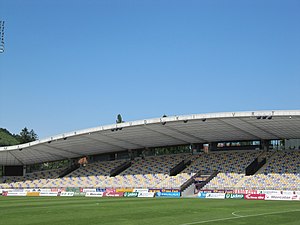Ljudski vrt
Ljudski vrt (English: People's Garden[3]) is a football stadium in Maribor, the second-largest city of Slovenia.
The record attendance of 20,000 was set at a match between Maribor and Proleter in 1973, which was before the ground's conversion to an all-seater stadium in 1998.
In 1999, when Maribor qualified for the UEFA Champions League group stages for the first time, the stadium underwent further renovations and adjustments.
The area, known today as Ljudski vrt, was originally located outside the city walls of Maribor and served as a cemetery for centuries.
[4] At the beginning of the 20th century, the area became a recreational centre of the city, and records from 1901 show that tennis was already being played there at that time.
[8] In January 1920, Rapid signed a contract with the Maribor's city authorities to acquire a football field in the area for the next ten years.
[4][11] At the time, the main pitch was fully enclosed by banking, with concrete terraces and seats located on the west side.
[12] The primary user of the stadium and the new club offices was to be NK Branik, however, they disbanded in 1960 due to the food poisoning affair, when the club's officials allegedly bribed a hotel waiter to deliberately poison the players of the visiting team, NK Karlovac, before the decisive play-off match for promotion to the Yugoslav Second League.
[13] Maribor found its home at Ljudski vrt, and on 25 June 1961, the club played its first match at the stadium, while the main grandstand was still under construction.
[15] During the 1967–68 season, when Maribor competed in the Yugoslav First League for the first time, the club renovated the dressing rooms, bathrooms and sanitary facilities, which were in poor condition and inadequate for the top division level.
[6] In 1998, the concrete stands were abolished and replaced by a seating area as part of the ground's conversion to an all-seater stadium.
[11] Maribor's results in domestic and international competitions in the 1990s were the reason why political and sports officials in the city began to think about a new stadium.
[36] The first competitive game was played on 7 September 1994 in the UEFA Euro 1996 qualifiers, when Slovenia hosted Italy.
[45] One of the first events at the renovated stadium was the musical Zorba in June 2008, performed by the Slovene National Theatre Maribor, which had an attendance of around 6,000 people.
[46] Ljudski vrt was also the venue for the annual Piše se leto concert, organised by the Večer newspaper.
[50] The highest attendance recorded at Ljudski vrt is 20,000, for Maribor's match against Proleter in the first leg of the promotion play-offs for the Yugoslav First League, on 8 July 1973.
[52] In addition, Ljudski vrt is the record holder for the highest average attendance in the Slovenian League season with 5,289, also set in 1996–97.
[53] Public transport to the stadium includes rail and bus, but there is a lack of dedicated parking spaces.





